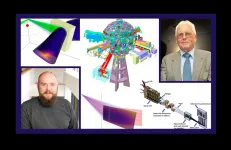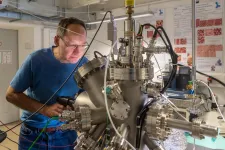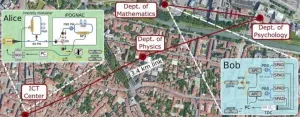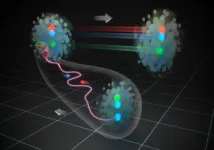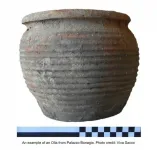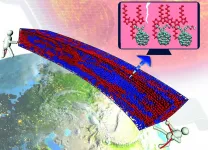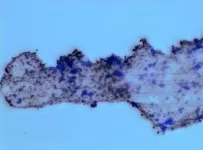(Press-News.org) Laser-produced high energy density plasmas, akin to those found in stars, nuclear explosions, and the core of giant planets, may be the most extreme state of matter created on Earth. Now scientists at the U.S. Department of Energy's (DOE) Princeton Plasma Physics Laboratory (PPPL), building on nearly a decade of collaboration with the National Ignition Facility (NIF) at the DOE's Lawrence Livermore National Laboratory (LLNL), have designed a novel X-ray crystal spectrometer to provide high-resolution measurements of a challenging feature of NIF-produced HED plasmas.
Most powerful lasers
The collaboration with NIF, home to the world's largest and most powerful lasers, represents a major expansion for PPPL's X-ray crystal spectrometer designs, which are used by fusion laboratories around the world to record on detectors the spectrum of X-rays from the plasma - gases of electrons and atomic nuclei, or ions -- that fuel fusion reactions. These PPPL instruments measure profiles of key parameters such as the ion and electron temperatures in large volumes of hot plasmas that are magnetically confined in doughnut-shaped tokamak fusion devices to facilitate fusion reactions. By contrast, NIF laser-produced HED plasmas are tiny, point-like substances that require differently designed spectrometers for high-resolution studies.
"We previously built a spectrometer for the NIF that has been quite successful," said physicist Manfred Bitter, a long-time member of the PPPL design team. That spectrometer, delivered in 2017, provides high-resolution measurements of the temperature and density of NIF extreme plasmas for inertial confinement fusion experiments, and the data obtained have been presented in invited talks and peer-reviewed publications.
The HED experiments differ from the magnetically confined experiments that PPPL conducts in many respects. A major difference that affects the design of spectrometers is the small size of laser-produced HED plasmas, whose volumes are typically on the order of a cubic millimeter and can be considered as point-like X-ray sources. This small size compares with extended tokamak plasmas, which have volumes of several cubic meters and require very different diagnostic designs.
New design challenges
PPPL's new spectrometer for the NIF responds to new design challenges. They call for measuring a fine structure in the X-ray spectra of HED plasmas that reveals their state of matter under extreme conditions. Such measurements can show whether the ions in the highly-compressed plasma are in a random, or fluid-like arrangement, or in a more ordered lattice-like arrangement that is typical for a solid.
This critical state of matter can be detected in what is called the Extended X-ray Absorption Fine-Structure (EXAFS) -- the technical term for the tiny intensity variations, or wiggles, in the X-ray energy spectrum recorded by crystal spectrometers. "The standard crystal forms which have been used for the diagnosis of HED plasmas, so far, cannot be used in this case," said Bitter, lead author of a paper in the Review of Scientific Instruments that describes the PPPL spectrometer being fabricated for the NIF. "Their resolution and photon throughput are not high enough and they introduce imaging and other errors."
These are the challenges the new crystal spectrometer must meet, Bitter said:
To reduce statistical errors, the design must be adapted to a high throughput of photons, the particles of light that X-ray sources and all other light sources emit. The X-ray reflecting crystal must therefore have a large area without introducing any of the imaging errors that large standard crystals tend to produce.
The crystal must reflect the wide range of X-ray energies over which the fine structure is observed.
Finally, the crystal and detector arrangements must minimize the effects of what is called source-size broadening. This problem results from the tiny, but not negligible, size of a laser-produced HED plasma that deteriorates, or muddles, the spectral resolution. The standard crystal forms that have been used until now cannot fully eliminate or minimize these broadening effects.
Bitter and PPPL physicist Novimir Pablant worked together to design the new spectrometer. Bitter came up with the idea of shaping the crystal that mirrors the spectrum in the form of what is called a sinusoidal spiral. These spirals denote a family of curves whose shapes can be determined to assume any real value, making it possible to select a special shape of crystal. Pablant, who co-authored the Review of Scientific Instruments paper, created a computer code to design the sinusoidal crystal in a process that he outlines in a recently submitted companion paper to the same journal.
"I developed a code that would allow me to model the complicated 3-D shape of the crystal and simulate the performance of this new spectrometer design," Pablant said. The simulations showed that the performance of the crystal marked "a five-times improvement in energy resolution for this NIF project compared to their previous spectrometer design."
The collaboration will move to NIF in October when the new spectrometer is scheduled for testing there, with researchers at both laboratories eagerly awaiting the results. "Experiments at the NIF that measure the EXFAS spectrum at high X-ray energies have had low signals," said Marilyn Schneider, leader of the Radiative Properties Group at the Physics and Life Sciences Directorate of LLNL and a co-author of the paper. "The spectrometer design described in the paper concentrates the low signal and increases the signal-to-noise ratio while maintaining the high resolution required for observing EXAFS," she said.
Experimental verification is the next step required. "We arrived at this design after several attempts and are confident that it will work," said Bitter. "But we have not yet tested the design at NIF and must see how it performs in the fall."
INFORMATION:
PPPL co-authors of the paper include physicists Ken Hill, Lan Gao, Luis Delgado-Aparicio, Brent Stratton, and Brian Kraus. Philip Efthimion, who heads the PPPL Plasma Science & Technology Department that oversaw this work, was also a co-author. Co-authors at NIF include physicists Federica Coppari, Robert Kauffman, Michael MacDonald, Andrew MacPhee, Yuan Ping, Stanislav Stoupin, and Daniel Thorn. The DOE Office of Science supported this research.
PPPL, on Princeton University's Forrestal Campus in Plainsboro, N.J., is devoted to creating new knowledge about the physics of plasmas -- ultra-hot, charged gases -- and to developing practical solutions for the creation of fusion energy. The Laboratory is managed by the University for the U.S. Department of Energy's Office of Science, which is the single largest supporter of basic research in the physical sciences in the United States and is working to address some of the most pressing challenges of our time. For more information, visit energy.gov/science
An international research team led by members from the Technical University of Munich, the Deutsches Museum, Munich, and the Swedish Linköping University has developed a method to manufacture two-dimensional polymers with the thickness of a single molecule. The polymers are formed on a surface by the action of light. The discovery paves the way to new ultrathin and functional materials.
The quest for new two-dimensional materials has rapidly intensified after the discovery of graphene - a supermaterial whose excellent properties include high conductivity and strength, making it incredibly versatile.
Two main ...
WASHINGTON -- In a new study, researchers demonstrate an automated, easy-to-operate quantum key distribution (QKD) system using the fiber network in the city of Padua, Italy. The field test represents an important step toward implementing this highly secure quantum communication technology using the type of communication networks already in place in many regions around the world.
QKD offers impenetrable encryption for data communication because it uses the quantum properties of light to generate secure random keys for encrypting and decrypting data.
"QKD can be useful in any situation where security is paramount because it offers unconditional security for the key exchange process," ...
Two gene variants found in African American women may explain why they are more likely to be diagnosed with triple negative breast cancer (TNBC) than white women of European ancestry, according to Weill Cornell Medicine and NewYork-Presbyterian investigators. The study findings may have implications for developing better risk assessment tools for TNBC in African American women and for understanding why they have poorer TNBC outcomes.
In a study, published April 29 in Scientific Reports, the investigators found that a version of the ANKLE1 gene that can be protective against TNBC is less likely to be found in African American women than white women of European ancestry. In addition, African American women with a mutation in the Duffy gene, which plays a role in inflammation, ...
Inside each proton or neutron there are three quarks bound by gluons. Until now, it has often been assumed that two of them form a "stable" pair known as a diquark. It seems, however, that it's the end of the road for the diquarks in physics. This is one of the conclusions of the new model of proton-proton or proton-nucleus collisions, which takes into account the interactions of gluons with the sea of virtual quarks and antiquarks.
In physics, the emergence of a new theoretical model often augurs badly for old concepts. This is also the case with the description of collisions of protons with protons or atomic nuclei, proposed by scientists from the Institute of Nuclear Physics of the Polish Academy of Sciences (IFJ PAN) ...
Organic residues on ceramic pottery are a valuable resource for understanding medieval cuisines of Islamic-ruled Sicily, according to a study published June 9, 2021 in the open-access journal PLOS ONE by Jasmine Lundy of the University of York, UK and colleagues.
During the 9th to 12th century AD, Sicily was under Islamic rule. This transition is known to have profoundly impacted the region, and the capital city of Palermo thrived as an economic and cultural center of the Mediterranean Islamic world. But little is known about how the lives of people in the region were impacted during this important time period.
In this study, researchers examined organic residues of plant and animal products on ceramic pottery to gain insights ...
Today, solar energy provides 2% of U.S. power. However, by 2050, renewables are predicted to be the most used energy source (surpassing petroleum and other liquids, natural gas, and coal) and solar will overtake wind as the leading source of renewable power. To reach that point, and to make solar power more affordable, solar technologies still require a number of breakthroughs. One is the ability to more efficiently transform photons of light from the Sun into useable energy.Organic photovoltaics max out at 15% to 20% efficiency -- substantial, but a limit on solar energy's potential. Lehigh University engineer Ganesh Balasubramanian, like many others, wondered if there were ways to improve the design of solar cells to make them more ...
GRAND RAPIDS, Mich. (JUNE 8, 2021) -- Chronic inflammation in the gut may propel processes in the body that give rise to Parkinson's disease, according to a study by scientists at Van Andel Institute and Roche.
The study, published in Free Neuropathology, is the latest in a growing list that links the gut and the immune system to Parkinson's. The researchers' findings in an experimental mouse model of gut inflammation track with several large-scale epidemiological studies that show an association between Parkinson's and inflammatory bowel diseases, such as ulcerative colitis and Crohn's disease.
Epidemiological evidence from other groups indicates the risk of developing Parkinson's fades in certain people whose ...
Small pieces of plastic are everywhere, stretching from urban environments to pristine wilderness. Left to their own devices, it can take hundreds of years for them to degrade completely. Catalysts activated by sunlight could speed up the process, but getting these compounds to interact with microplastics is difficult. In a proof-of-concept study, researchers reporting in ACS Applied Materials & Interfaces developed self-propelled microrobots that can swim, attach to plastics and break them down.
While plastic products are omnipresent indoors, plastic waste and broken bits now litter the outdoors, too. The smallest of these ...
TORONTO, June 9, 2021 - Researchers from York University and the University of British Columbia have found social media use to be one of the factors related to the spread of COVID-19 within dozens of countries during the early stages of the pandemic.
The researchers say this finding resembles other examples of social media misinformation ranging from the initial phase of vaccine rollout to the 2021 Capitol riot in the United States.
Countries with high social media use leading to off-line political action prior to the pandemic, as surveyed before the pandemic by V-Dem (a database from the University of Gothenburg), showed ...
Skoltech researchers and their colleagues from RAS Institute for Physics of Microstructures, Lobachevsky State University of Nizhny Novgorod, ITMO University, Lomonosov Moscow State University, and A.M. Prokhorov General Physics Institute have found a way to increase photoluminescence in silicon, the notoriously poor emitter and absorber of photons at the heart of all modern electronics. This discovery may pave the way to photonic integrated circuits, boosting their performance. The paper was published in the journal Laser and Photonics Reviews.
"Natural selection" in semiconductor technology ...
